



No AGP or coccidiostat in your chicken feed? A low content soy anti-nutritional factors in the starter diet is crucial for good results.
Introduction
There is sufficient evidence on the negative effects of soy anti-nutritional factors (ANF) on the development and growth of broiler chickens, as has been previously addressed on this website (Blanch, 2020 a, b). It is also well known that the damaging consequences of soy ANF become more relevant in young chicks during the starter period, which are highly vulnerable since they are still physiologically and immunologically immature. The excessive occurrence of soy ANF in starter feed can impair the intestinal homeostasis of young birds, causing chronic subclinical inflammations, which can be the prelude to intestinal infectious disorders.
The decreasing use of antibiotics in poultry production, as well as the rising trend to dispense with coccidiostats and use coccidiosis vaccines, is currently revealing underlying intestinal issues, which are related to the dietary ingredients, particularly to soybean meal (SBM). This new paradigm in poultry forces us to review the quality of the SBM we use, its ANF content as well as its level of inclusion in starter feed (Blanch and Brøkner, 2020).
This article presents the results of a couple of experimental trials with broiler chickens vaccinated against coccidiosis and fed with / without antibiotic-supplemented diets, with different soy ANF contents. These results highlight the importance of reducing soy ANF in the starter feed when you no longer have antibiotics in feed or when you use coccidiosis vaccines.
Enzyme-treated SBM; a good tool to reduce ANF in starter diets
There are different types of soy-processed products for animal feeding derived from different processes, always with the aim of reducing the ANF content: extruded soy, alcohol - and/or water-treated soy, fermented soy and enzyme-treated soy. However, not all of these assortments of products are truly comparable. The important thing when choosing a processed soy protein is to ensure that, in addition to having a very low ANF level, it is a well standardized product without large disparities in its composition. In this sense, the authentic enzymatic treatment of soybean meal is a very cutting-edge biotechnological process that applies substrate-specific enzymes, under precise conditions, in order to achieve the desired product specs in a reliable way. It is quite possibly the most sustainable process to reduce all the major ANFs at once, without damaging the protein in the final product.
Hamlet Protein A/S (Horsens, Denmark) has led the development of enzyme-treated soy proteins for 30 years, with HP AviStart being its main poultry product. Compared to standard soybean meal, HP AviStart contains an extremely low level of ANF (Figure 1), which may impair the intestinal homeostasis in young chicks. The replacement of part of the SBM in the starter feed with HP AviStart results in a substantial reduction of the ANF content.
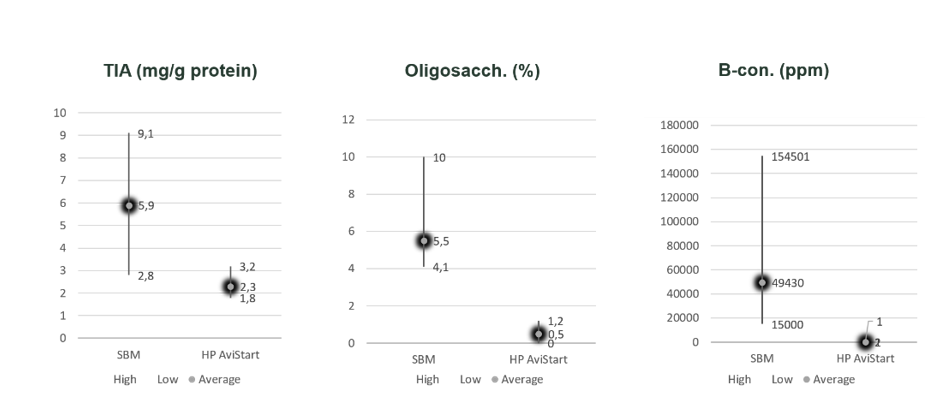
Therefore, the immature gut of newly hatched chicks benefit from feeding with HP AviStart, stimulating their healthy development from day one. HP AviStart with its low ANF content is proven to boost the intestinal development of young chicks (Figure 2, Hamlet Protein internal data). This will promote nutrient absorption and consequently improve growth performance. In other words, it is a physiological investment in the first period of life, so that a clear benefit is achieved at the end of the production cycle. Furthermore, a well-developed epithelium in the early stages of life will be much better prepared to deal with potential intestinal disorders later in the bird's life.
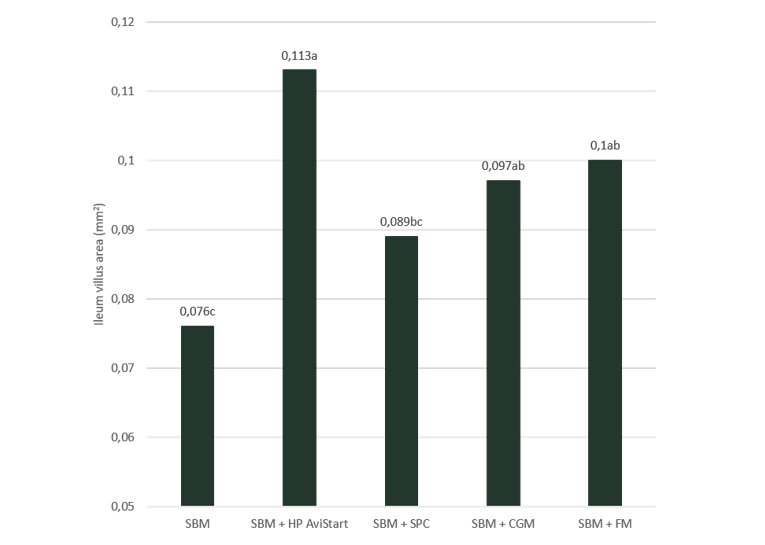
Enzyme-treated soy protein, a protein of choice in ABF systems
The positive effect of this type of enzymatically treated proteins in chickens is even more accentuated when they are included in feed without AGP or coccidiostats, since these birds might be more susceptible to intestinal disorders. In this sense, two trials with broiler chickens were carried out at Southern Poultry Research Inc. (Athens, Georgia, USA), in order to study the effect of soy ANF reduction in chicken starter feed, by replacing part of the SBM with 5% HP AviStart, on the performance of birds vaccinated against coccidiosis, with or without AGP (Bacitracin methylene disalicylate). Furthermore, in the second study, with the same dietary treatments, half of the chickens were mildly challenged with a pathogenic strain of Clostridium perfringens to assess the effect of reducing ANF in feed when subclinical intestinal infections occur.
2,400 male Cobb 500 newly hatched birds were used in the first study (Lumpkins et al., 2017). Four different diets were used during the starter phase (days 1-14): Treatment 1) corn-soy, no AGP (control); Treatment 2) corn-soy + AGP during the entire trial length; Treatment 3) corn-soy + HP AviStart (only during the starter phase, 0-14 days) + AGP; Treatment 4) corn-soy + HP AviStart (only during the starter phase, 0-14 days), and no AGP. During the grower (days 14-35) and finisher period (days 35-42) the birds were all fed the same diet, except for treatment 2 and 3 where an AGP was used throughout the study. At the end of the experimental period (42 days), an effect of the dietary treatments on FCR was observed, birds on control having a significantly higher FCR than all other dietary treatments (Figure 3). HP AviStart improved FCR in diets without AGP and did not result in any difference in diets with AGP. The study clearly showed that 5 % HP AviStart in the starter diet offered equivalent growth and performance to a commonly used AGP through the entire cycle. It was concluded that enzyme-treated soy protein is a suitable tool for AGP-free producers looking for a way to regain lost performance.
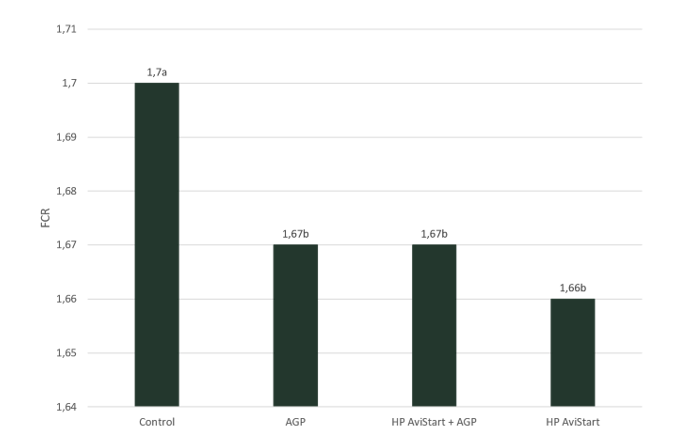
The objective of the second study (Rasmussen et al., 2019) was to assess the effect of enzyme-treated soy protein (HP AviStart), in starter feed, with or without AGP (BMD), on the performance of Clostridium perfringens infected or uninfected chickens. A total of 1600 day-of-hatch Cobb 500 male broiler chickens were assigned to eight treatments. Treatment 1 (uninfected birds; negative control) and treatment 2 (infected birds; positive control) were based on a corn-SBM starter feed (d0-14). Treatments 3 (uninfected birds) and treatment 4 (infected birds) consisted of a partial replacement of SBM with 5% HP AviStart in the starter feed (d0-14). Treatment 5 (uninfected birds) and treatment 6 (infected birds) consisted of the same corn-SBM starter diet as treatments 1 and 2 but supplemented with AGP through the entire production cycle (d0-42). Treatment 7 (uninfected birds) and treatment 8 (infected birds) contained 5% HP AviStart in the starter diet as treatments 2 and 3 (d0-14), but with AGP supplementation through the entire cycle (d0-42). All birds were vaccinated against coccidiosis. On days 19, 20 and 21, birds from treatments 2, 4, 6 and 8 were challenged with C. perfringens orally. Results (0-42 days) from uninfected and infected birds are shown in Figured 4 and 5, respectively.
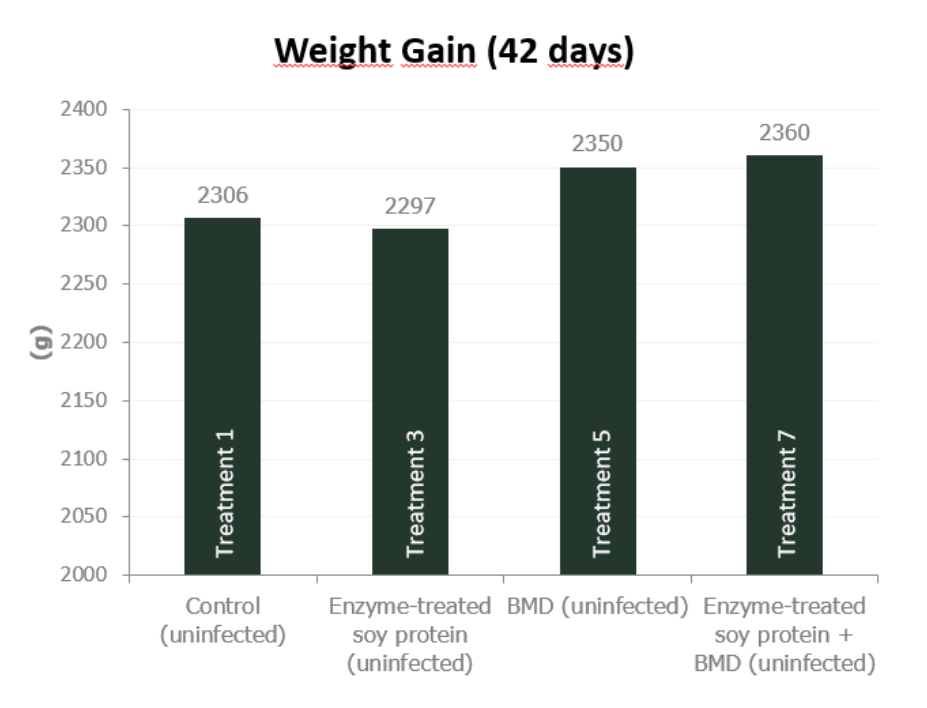
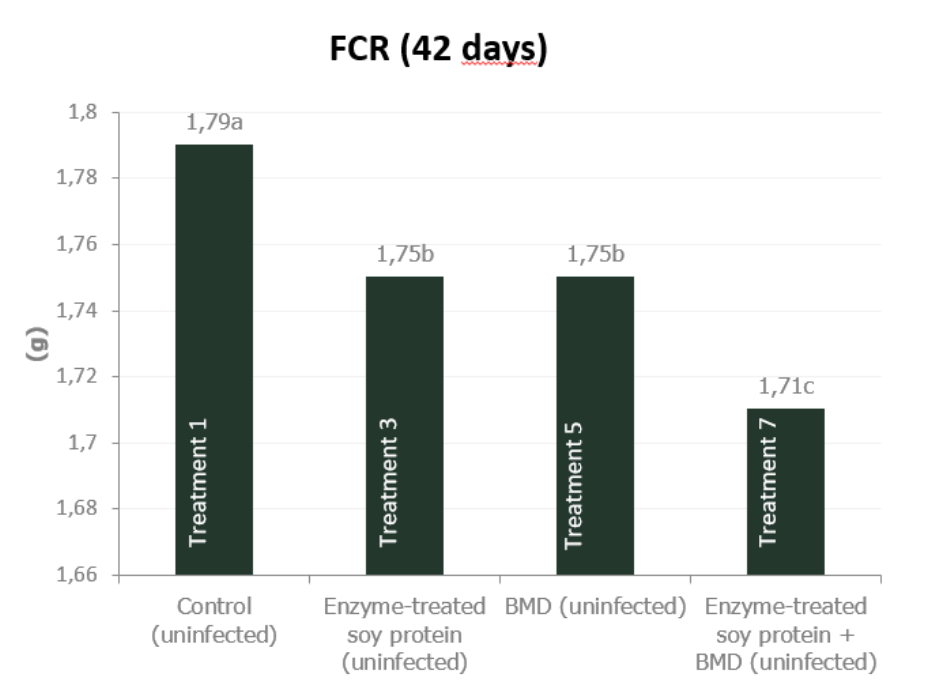
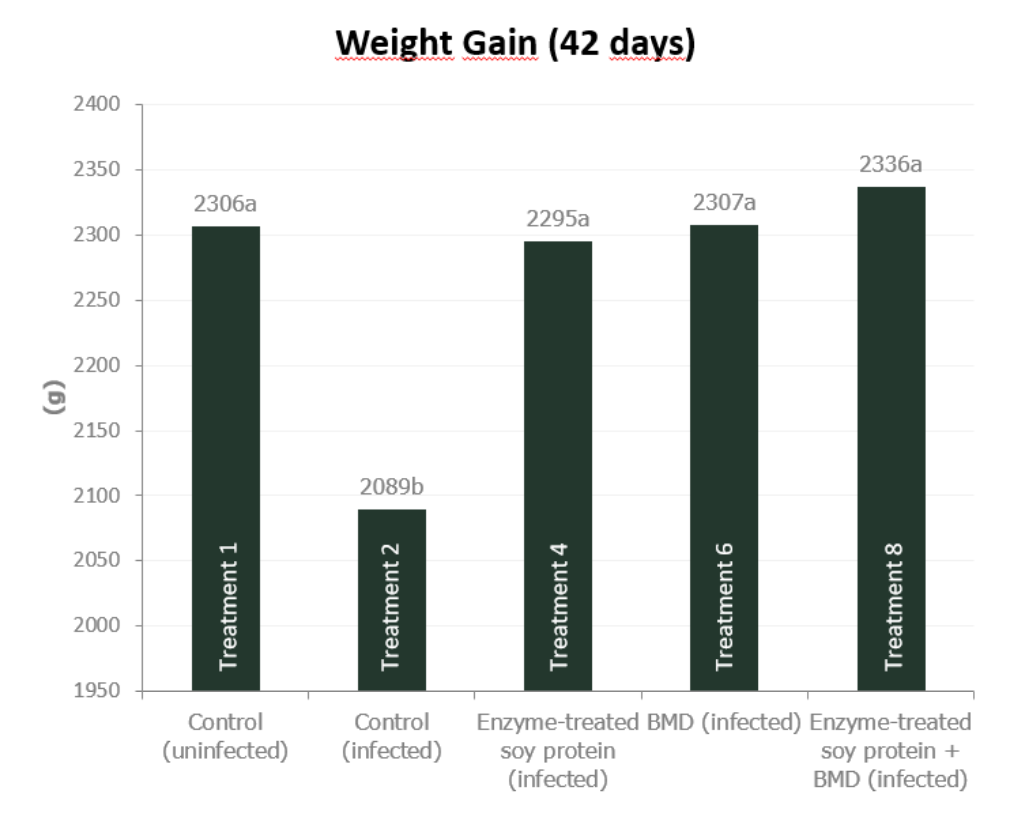
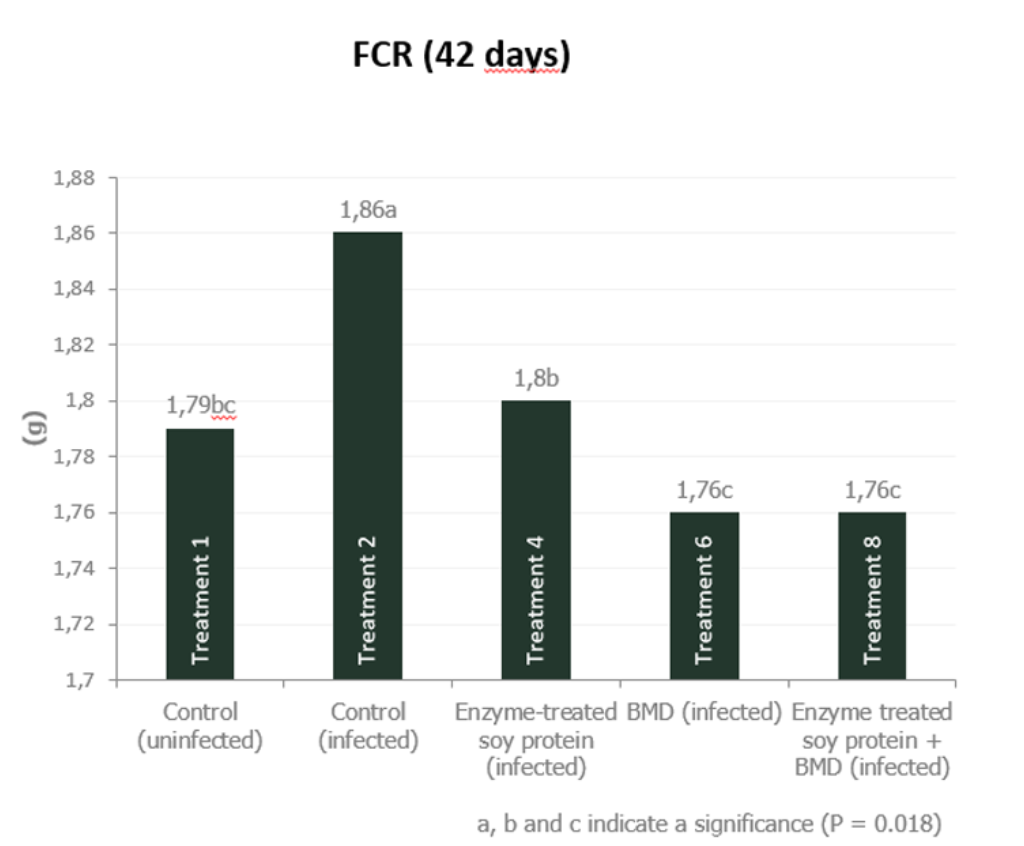
The addition of 5% enzyme-treated soy protein (HP AviStart) in the starter feed and/or AGP (55 ppm of BMD) through the entire feeding period significantly improved FCR of coccidiosis-vaccinated healthy chickens from 0 to 42 days of life (Figure 4). However, early administration of live oocysts of the vaccine can cause a reduction in growth and may increase the chick’s susceptibility to secondary infections (Li et al., 2005; Ritzi et al., 2016). These potential undesirable consequences of coccidiosis vaccine administration at a young age can be overcome by proper and uniform delivery of the vaccine, as well as the chick having a healthy and well-developed intestinal tract. Thus, low soy ANF starter diets have the potential to enhance intestinal epithelium development, while reducing the susceptibility of chicks to intestinal disorders. Based on our findings, enzyme-treated soy protein (HP AviStart) may be able to attenuate the negative consequences of early vaccine administration.
Furthermore, 5% of enzyme-treated soy protein (HP AviStart) in the starter feed, with or without AGP (55 ppm of BMD) through the entire feeding period, equaled the performance of Clostridium perfringens-infected broiler chickens, both weight and FCR, to that of uninfected chickens (Figure 5). As mentioned above, the reduction of ANF in the starter diet by incorporating enzyme-treated soy protein (HP AviStart) certainly helped the chicks to be better prepared to face possible challenges in the intestine, such as common subclinical infections by Clostridium perfringens. An optimal intestinal integrity, as well as a good use of the protein in the diet, from the beginning of the chick's life are crucial to overcome this type of recurrent mild infections in the field. This is indeed particularly important in today's antibiotic-free production systems.
In summary, the type of protein in the (pre-) starter feed and its ANF content undoubtedly play an important role in the establishment of intestinal homeostasis in chicks. Thus, it is highly relevant that this inference is taken into account when antibiotics are not used in broiler chicken production. Thus, the inclusion of enzyme-treated soy protein, with a very low content of ANF, in starter feed is a suitable tool to maintain the performance of the birds when it comes to coccidiosis vaccine and/or antibiotic free broiler production systems.
| References | ||||
|---|---|---|---|---|
| Blanch A. | ||||
| (2020 a.) | Soy trypsin inhibitors do affect the growth and gut health of chickens. | https://www.thepoultrysite.com/articles/soy-trypsin-inhibitors-do-affect-the-growth-and-gut-health-of-chickens | ||
| Blanch A. | ||||
| (2020 b.) | Soy oligosaccharides and beta-conglycinin, behind gut inflammations, wet droppings and footpad dermatitis in chickens. | https://www.thepoultrysite.com/articles/soy-oligosaccharides-and-beta-conglycinin-behind-gut-inflammations-wet-droppings-and-footpad-dermatitis--n-chickens | ||
| Blanch A. and C. Brøkner, | ||||
| (2020.) | Feed-induced gut inflammation and oxidative stress in chickens; what antibiotic growth promoters actually hide. | https://www.thepoultrysite.com/articles/feed-induced-gut-inflammation-and-oxidative-stress-in-chickens-what-antibiotic-growth-promoters-actually-hide | ||
| Lumpkins, B. et al., | ||||
| (2017.) | Evaluation of HP AviStart in broiler starter diets with and without and antibiotic feeding program.. Proceedings of the 21st European Symposium on Poultry Nutrition. | https://doi.org/10.3920/978-90-8686-851-3 | ||
| Rasmussen, S. et al. | ||||
| (2019) | Effect of an enzyme-treated soy protein on the performance of broiler chickensinfected or uninfected with Clostridium perfringens. | Poultry Science Association 108th Annual Meeting Abstracts: 145. | ||
| Li G.Q. et al., | ||||
| (2005.) | Responses of chickens vaccinated with a live attenuated multi-valent ionophore-tolerant Eimeria vaccine.. Vet Parasitol | 129:179–186 | ||
| Ritzi M.M. et al., 2016. | ||||
| (2016) | Combination of probiotics and coccidiosis vaccine enhances protection against an Eimeria challenge.. Vet Res | 47, 111 | https://doi.org/10.1186/s13567-016-0397-y |











